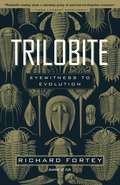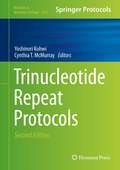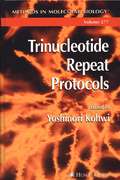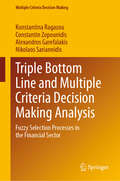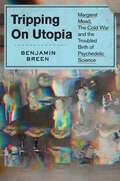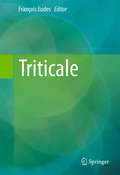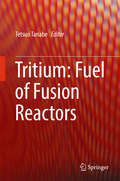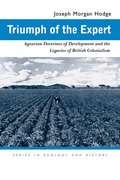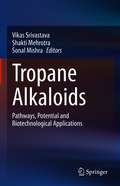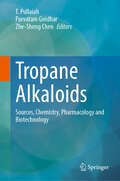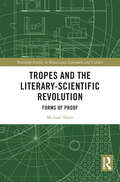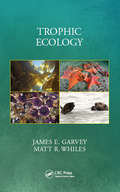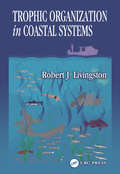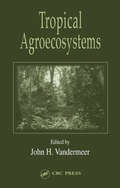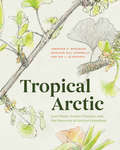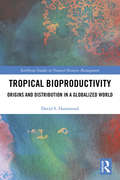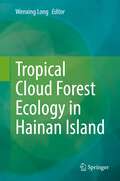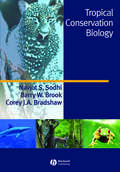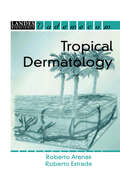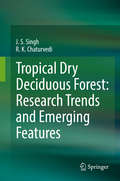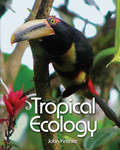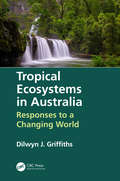- Table View
- List View
Trilobite: Eyewitness to Evolution
by Richard ForteyWith Trilobite, Richard Fortey, paleontologist and author of the acclaimed Life, offers a marvelously written, smart and compelling, accessible and witty scientific narrative of the most ubiquitous of fossil creatures. Trilobites were shelled animals that lived in the oceans over five hundred million years ago. As bewilderingly diverse then as the beetle is today, they survived in the arctic or the tropics, were spiky or smooth, were large as lobsters or small as fleas. And because they flourished for three hundred million years, they can be used to glimpse a less evolved world of ancient continents and vanished oceans. Erudite and entertaining, this book is a uniquely exuberant homage to a fabulously singular species.
Trinity: The Treachery and Pursuit of the Most Dangerous Spy in History
by Frank Close'Everything about this story is astounding' Bryan Appleyard, Sunday Times"Trinity" was the codename for the test explosion of the atomic bomb in New Mexico on 16 July 1945. Trinity is now also the extraordinary story of the bomb's metaphorical father, Rudolf Peierls; his intellectual son, the atomic spy, Klaus Fuchs, and the ghosts of the security services in Britain, the USA and USSR.Against the background of pre-war Nazi Germany, the Second World War and the following Cold War, the book traces how Peierls brought Fuchs into his family and his laboratory, only to be betrayed. It describes in unprecedented detail how Fuchs became a spy, his motivations and the information he passed to his Soviet contacts, both in the UK and after he went with Peierls to join the Manhattan Project at Los Alamos in 1944. Frank Close is himself a distinguished nuclear physicist: uniquely, the book explains the science as well as the spying.Fuchs returned to Britain in August 1946 still undetected and became central to the UK's independent effort to develop nuclear weapons. Close describes the febrile atmosphere at Harwell, the nuclear physics laboratory near Oxford, where many of the key players were quartered, and the charged relationships which developed there. He uncovers fresh evidence about the role of the crucial VENONA signals decryptions, and shows how, despite mistakes made by both MI5 and the FBI, the net gradually closed around Fuchs, building an intolerable pressure which finally cracked him.The Soviet Union exploded its first nuclear device in August 1949, far earlier than the US or UK expected. In 1951, the US Congressional Committee on Atomic Espionage concluded, 'Fuchs alone has influenced the safety of more people and accomplished greater damage than any other spy not only in the history of the United States, but in the history of nations'. This book is the most comprehensive account yet published of these events, and of the tragic figure at their centre.
Trinucleotide Repeat Protocols
by Yoshinori Kohwi Cynthia T. McmurrayTwo decades have passed since trinucleotide repeat expansion was first discovered in genes responsible for certain neurological diseases. Since then, new technologies have developed and innovative concepts have emerged, which may prove useful in devising therapeutic approaches to neurological diseases. Divided into six convenient sections, Trinucleotide Repeat Protocols, Second Edition covers a wide range of topics such as an overview of trinucleotide repeat diseases, synaptic plasticity, embryonic stem (ES) cell-related protocols with a focus on HD, RNA-related protocols, and analysis of epigenetic modification in fragile X syndrome. This edition focuses not only on direct analysis of trinucleotide repeat diseases but also on alternative approaches for the analysis of trinucleotide repeat diseases, with the hope that this will result in a better understanding of the mechanisms and future therapeutic prospects for treatment of these diseases. Written in the successful Methods in Molecular BiologyTM series format, chapters include introductions to their respective topics, lists of the necessary materials and reagents, step-by-step, readily reproducible protocols, and notes on troubleshooting and avoiding known pitfalls. Authoritative and easily accessible, Trinucleotide Repeat Protocols, Second Edition seeks to serve researchers with its thorough methodologies on this expanding field.
Trinucleotide Repeat Protocols
by Yoshinori KohwiEstablished leaders in trinucleotide repeat disease describe in step-by-step detail their best techniques for studying trinucleotide pathology at the molecular level. The protocols cover a variety of targets, ranging from DNA and RNA to proteins and whole animals, and focus not only on causal genes, but also on their consequent affected products, such as transcription factors, neurotransmitter receptors, proteasomes, and mitochondria/oxidation damage. Experimental systems employed include E. coli, yeast, C. elegans, mouse, and generally take a clinical point of view. The authors utilize a wide range of techniques, including gel electrophoresis, quantitative RT-PCR, immunological analysis, antibody usage and its applications, receptor assays using radioisotope handling, gene delivery by virus, brain cell and organotypic cultures, gender dependency, and neuron structure analysis.
Triple Bottom Line and Multiple Criteria Decision Making Analysis: Fuzzy Selection Processes in the Financial Sector (Multiple Criteria Decision Making)
by Constantin Zopounidis Konstantina Ragazou Alexandros Garefalakis Nikolaos SariannidisThis book offers a comprehensive compilation of research on the evaluation of the most environmentally and socially responsible financial institutions using a multiple criteria decision-making (MCDM) approach, with a focus on the principles of the Triple Bottom Line (TBL) model. Contributed by highly esteemed scholars in the field of MCDM/A, the book serves as a distinctive global reference guide that focuses on the examination, quantification, and administration of sustainability in relation to the TBL within a multidimensional framework for decision analysis. It presents the implementation of a set of MCDA techniques addressing challenges in the accounting systems of financial institutions and facilitating the identification of the optimal sustainable option within this domain. It highlights recent advancements in decision-making methodologies, exemplified through practical applications in the financial industry, particularly focusing on sustainability-related subjects. As such, scholars and policymakers will find this book to be a valuable resource.
Tripping on Utopia: Margaret Mead, the Cold War, and the Troubled Birth of Psychedelic Science
by Benjamin BreenA bold and brilliant revisionist take on the history of psychedelics in the twentieth century, illuminating how a culture of experimental drugs shaped the Cold War and the birth of Silicon Valley."It was not the Baby Boomers who ushered in the first era of widespread drug experimentation. It was their parents." Far from the repressed traditionalists they are often painted as, the generation that survived the second World War emerged with a profoundly ambitious sense of social experimentation. In the '40s and '50s, transformative drugs rapidly entered mainstream culture, where they were not only legal, but openly celebrated. American physician John C. Lilly infamously dosed dolphins (and himself) with LSD in a NASA-funded effort to teach dolphins to talk. A tripping Cary Grant mumbled into a Dictaphone about Hegel as astronaut John Glenn returned to Earth. At the center of this revolution were the pioneering anthropologists—and star-crossed lovers—Margaret Mead and Gregory Bateson. Convinced the world was headed toward certain disaster, Mead and Bateson made it their life&’s mission to reshape humanity through a new science of consciousness expansion, but soon found themselves at odds with the government bodies who funded their work, whose intentions were less than pure. Mead and Bateson's partnership unlocks an untold chapter in the history of the twentieth century, linking drug researchers with CIA agents, outsider sexologists, and the founders of the Information Age. As we follow Mead and Bateson&’s fractured love affair from the malarial jungles of New Guinea to the temples of Bali, from the espionage of WWII to the scientific revolutions of the Cold War, a new origin story for psychedelic science emerges.
Triticale
by François EudesTriticale crop species has received substantial research support since the mid-20th century making it a commercial success in many countries, in diverse value propositions. However, no recent book captures the new knowledge and progresses made in more than 2 decades. The purpose of this work is to review and collate the new knowledge of triticale plant biology and agronomy, while considering the contribution of biotechnology enablers such as molecular markers, doubled haploid technology and genetic engineering in breeding for traits important for crop production, feed, food and industrial end-uses.
Tritium: Fuel of Fusion Reactors
by Tetsuo TanabeThis book focuses on tritium as a fuel for fusion reactors and a next-generation energy source. Following an introduction of tritium as a hydrogen radioisotope, important issues involved in establishing safe and economical tritium fuel cycles including breeding for a fusion reactor are summarized; these include the handling of large amounts of tritium: confinement, leakage, contamination, permeation, regulation and tritium accountancy, and impacts on surrounding areas. Targeting and encouraging the students and technicians who will design and operate fusion reactors in the near future, this book offers a valuable resource on tritium science and technology.
Triumph of the Expert: Agrarian Doctrines of Development and the Legacies of British Colonialism
by Joseph Morgan HodgeJoseph Morgan Hodge changes the way we think about the evolution of scientific policies in the colonial and post-colonial world.
Tropane Alkaloids: Pathways, Potential and Biotechnological Applications
by Vikas Srivastava Shakti Mehrotra Sonal MishraThis book covers the current research on the biochemistry and biotechnological applications of plant-based Tropane alkaloids. Tropane alkaloids (TA)belong to the world’s oldest phytomedicines with their valuable ethno-pharmacological applications.The book compiles scientific ideas, perspectives and challenges in the application of TA in the present day. The book also provides case studies of Tropane alkaloid bearers. The book attempts to investigate the loop holes in existing methodologies, challenges and possible solutions through well thought-out scientific discussions from various eminent research groups. The book is split into three major sections. The first section includes an overview of Tropane alkaloids and their biosynthesis. This section addresses the biogenesis, evolutionary and ecological perspectives and enzymes in TA biosysnthesis. The second section covers aspects of genetic tools and biotechnological interventions in tropane alkaloid bearing plants. The third section presents various case studies in TA. This book is of high interest to students and researchers in biotechnology, plant biology and pharmacology. Alkaloids are of high medicinal value, and therefore, this book is an interesting read for industry experts, too.
Tropane Alkaloids: Sources, Chemistry, Pharmacology and Biotechnology
by T. Pullaiah Parvatam Giridhar Zhe-Sheng ChenThis book provides comprehensive information on tropane alkaloids, from their discovery to their pharmacological applications and biotechnological production. It focuses on the challenges and opportunities in the sustainable utilization of tropane alkaloid-yielding plants. The book serves as a desk reference for pharmacologists, biomedical scientists, biotechnologists, and herbal drug manufacturers, offering detailed insights into tropane alkaloid research from discovery to commercial production.Key topics include the chemistry and biosynthesis of tropane alkaloids, their occurrence in food commodities, and the cultivation of tropane alkaloid-yielding plants. This volume also explores the pharmacological uses of these compounds, with particular attention to their role as anticholinergic agents. Readers will discover the commercial aspects of tropane alkaloids, including the regulation, use and misuse of cocaine, a well-known narcotic. The authors present a unique combination of theoretical perspectives and practical insights, supported by descriptive illustrations and workflows that facilitate understanding and application, making this an essential guide for researchers and professionals in the pharmaceutical industry.This book is an invaluable resource for researchers, pharmacists, chemists, and industry professionals seeking to deepen their knowledge of tropane alkaloids. It is particularly relevant for those involved in the study or production of these compounds, offering guidance on the propagation of tropane alkaloid-producing plants and alternative production strategies.
Tropes and the Literary-Scientific Revolution: Forms of Proof (Routledge Studies in Renaissance Literature and Culture)
by Michael SlaterTropes and the Literary-Scientific Revolution: Forms of Proof argues that the rise of mechanical science in the seventeenth century had a profound impact on both language and literature. To the extent that new ideas about things were accompanied by new attitudes toward words, what we commonly regard as the “scientific revolution” inevitably bore literary dimensions as well. Literary tropes and forms underwent tremendous reassessment in the seventeenth century, and early modern science was shaped just as powerfully by contest over the place of literary figures, from personification and metaphor to anamorphosis and allegory. In their rejection of teleological explanations of natural motion, for instance, early modern philosophers often disputed the value of personification, a figural projection of interiority onto what was becoming increasingly a mechanical world. And allegory—a dominant mode of literature from the late Middle Ages until well into the Renaissance—became “the vice of those times,” as Thomas Rymer described it in 1674. This book shows that its acute devaluation was possible only in conjunction with a distinctively modern physics. Analyzing writings by Sidney, Shakespeare, Bacon, Jonson, Brahe, Kepler, Galileo, Hobbes, Descartes, and more, it asserts that the scientific revolution was a literary phenomenon, just as the literary revolution was also a scientific one.
Trophic Ecology
by James E. Garvey Matt WhilesThis book is a bridge between ecological paradigms – organismal/community approaches to food web dynamics and ecosystem-level approaches to production. The unification of organismal, community, and ecosystem approaches in ecology is emerging due to the growing availability of new techniques for assessing trophic interactions and their implications for ecosystems. Trophic Ecology is a formal text for both newcomers to the discipline as well as seasoned professionals looking for new ideas and refreshers on old topics. A wide range of topics are explained including autotrophy, heterotrophy, omnivory, decomposition, foraging behavior and theory, trophic cascades, bioenergetics, and production. The audience is upper-level undergraduate students and entry-level graduate students interested in autecological, organismal approaches to ecology, community and ecosystem ecology. It is also a reference text for instructors teaching upper-division courses, providing examples from the literature, quantitative approaches to teach, and new hypotheses yet to be fully tested by ecologists.
Trophic Organization in Coastal Systems (CRC Marine Science)
by Robert J. LivingstonDerived from an unprecedented research effort covering over 70 field years of field data in a series of studies, Trophic Organization in Coastal Systems represents an alternative approach to coastal research that has been successfully applied to coastal resource management issues. This unique book is based upon a sequence of long-term, interdiscipl
Trophoblasts: Methods and Protocols (Methods in Molecular Biology #2728)
by Sandeep RahaThis volume explores the latest approaches used to assess trophoblast angiogenesis, transport function, cellular respirations, migration, and invasion. The chapters in this book cover topics such as various methods to study and manipulate primary trophoblast cells; strategies using liposomes to deliver biomolecules to trophoblasts; in vitro models of the placenta that emulate the cellular interactions in the 3D uterine environment; and models exploring heterogenous cell types and 3D-organoid structures that represent cell-to-cell interactions in vivo. Written in the highly successful Methods in Molecular Biology series format, chapters include introductions to their respective topics, lists of the necessary materials and reagents, step-by-step, readily reproducible laboratory protocols, and tips on troubleshooting and avoiding known pitfalls.Cutting-edge and thorough, Trophoblasts: Methods and Protocols is a valuable resource that will help researchers better understand the function of the placenta and its complex contribution to maternal health and fetal development, and also provide greater insights to the area of study known as the developmental origins of health and diseases (DoHaD).
Tropical Agroecosystems (Advances in Agroecology)
by John H. VandermeerTropical areas present ecological, cultural, and political problems that demand analysis that is distinct from general ecological analysis. The tropical environment is special in many ways, from the lack of a biological down season (winter), to generally poor soil conditions, to a reliance on traditional methods of agriculture in an undeveloped society. Presenting a broad range of approaches to agroecosystem analysis, this book addresses specific ecological issues associated with agricultural production, examines two case studies of agricultural transformation and its effect on biodiversity, and discusses key landscape relationships between agroecosystems, wildlife, and human disease.
Tropical Arctic: Lost Plants, Future Climates, and the Discovery of Ancient Greenland
by Jennifer C. McElwain Marlene Hill Donnelly Ian J. GlasspoolAn illustrated visit to the tropical arctic of 205 million years ago when Greenland was green. While today’s Greenland is largely covered in ice, in the time of the dinosaurs the area was a lushly forested, tropical zone. Tropical Arctic tracks a ten-million-year window of Earth’s history when global temperatures soared and the vegetation of the world responded. A project over eighteen years in the making, Tropical Arctic is the result of a unique collaboration between two paleobotanists, Jennifer C. McElwain and Ian J. Glasspool, and award-winning scientific illustrator Marlene Hill Donnelly. They began with a simple question: “What was the color of a fossilized leaf?” Tropical Arctic answers that question and more, allowing readers to experience Triassic Greenland through three reconstructed landscapes and an expertly researched catalog of extinct plants. A stunning compilation of paint and pencil art, photos, maps, and engineered fossil models, Tropical Arctic blends art and science to bring a lost world to life. Readers will also enjoy a front-row seat to the scientific adventures of life in the field, with engaging anecdotes about analyzing fossils and learning to ward off polar bear attacks.Tropical Arctic explains our planet’s story of environmental upheaval, mass extinction, and resilience. By looking at Earth’s past, we see a glimpse of the future of our warming planet—and learn an important lesson for our time of climate change.
Tropical Bioproductivity: Origins and Distribution in a Globalized World (Earthscan Studies in Natural Resource Management)
by David HammondThis book investigates the fundamental role that tropical bioproductivity - or more specifically net primary productivity - has played in shaping the global geographies of food, finance, governance and people. The book examines the basic astronomical and thermal properties of our planet to illustrate the dynamic nature of the tropics and how the region resides at the very heart of global energetics, driving the environmental flows that shape planetary climate and bioproductivity. The author explores how the region’s relatively small, but hyper-productive, land area provided the groundswell for the economic, social, political and demographic changes that fuelled empires, European colonialism and nation-building. Also covered are discussions on how the critical intake of capital needed to fuel the industrial and technological revolutions driving modern globalization was first expropriated from the tropics by harnessing the region’s natural productivity and biological crop diversity and then transforming it into tradeable commodities using the inhabitants' labour and knowledge. With modern tropical nations accounting for the bulk of people living in poverty and registering some of the highest income disparities, the author presents cross-cutting evidence showing that their histories and the persistence of expropriating institutions have fostered anocratic tendencies, poor governance, unorthodox financial flows and mass migration. Tropical Bioproductivity cuts across vast geographies, topics and histories to deliver a readable narrative that links people, places and events with the environmental mechanics of our planet. It will be of interest to students and researchers in the areas of environmental studies, economics, history, agriculture, anthropology and geography.
Tropical Cloud Forest Ecology in Hainan Island
by Wenxing LongThis book introduces ecology of tropical cloud forests in China, a high-altitudinal tropical forest. The findings are novel in revealing environmental characteristics, community features, diversity patterns, plant strategies, community assembly mechanisms, and diversity-ecosystem functions of tropical cloud forests in China. The knowledge of this book will bridge the gaps of our understanding on the tropical forest in China and the world-wide, and will enrich the theory of tropical forest community ecology.Written by experts in the field, this book will serve as an invaluable reference for tropical forest ecology researchers.
Tropical Conservation Biology
by Navjot S. Sodhi Barry W. Brook Corey J. BradshawThis introductory textbook examines diminishing terrestrial and aquatic habitats in the tropics, covering a broad range of topics including the fate of the coral reefs; the impact of agriculture, urbanization, and logging on habitat depletion; and the effects of fire on plants and animal survival. Includes case studies and interviews with prominent conservation scientists to help situate key concepts in a real world context Covers a broad range of topics including: the fate of the coral reefs; the impact of agriculture, urbanization, and logging on habitat depletion; and the effects of fire on plants and animal survival Highlights conservation successes in the region, and emphasizes the need to integrate social issues, such as human hunger, into a tangible conservation plan Documents the current state of the field as it looks for ways to predict future outcomes and lessen human impact “Sodhi et al. have done a masterful job of compiling a great deal of literature from around the tropical realm, and they have laid out the book in a fruitful and straightforward manner…I plan to use it as a reference and as supplemental reading for several courses and I would encourage others to do the same.” Ecology, 90(4), 2009, pp. 1144–1145
Tropical Dermatology
by Roberto ArenasTropical diseases are not merely a group of nosologic diseases indigenous to the intertropical zone. Many are diseases of poor public health originating from poverty, ignorance, and population upheaval. Tropical dermatoses represent a public health problem in 127 countries with a population of 3 billion people who do not have access to health care.
Tropical Dry Deciduous Forest: Research Trends and Emerging Features
by J. S. Singh R. K ChaturvediTropical dry deciduous forests (TDFs) can be found in severe and extremely variable climates characterized by low annual rainfall, 5-6 dry months within the annual cycle, and nutrient-poor soil. Several terms have been used for this vegetation type such as seasonally dry tropical forest (SDTF), tropical dry deciduous forest, monsoon forest, caatinga, cuabal, etc. More than any other factor, the lack of precipitation during a prolonged portion of the year is what produces true dry forest, an ecosystem type characterized by plants and animals with specific adaptations to survive the long dry season. Deciduousness is the single most important adaptation among plants to the extended droughts. Most of the trees drop their leaves after the rains end, and essentially halt photosynthesis, as they would otherwise be unable to survive the water loss during the dry season. TDFs are subject to intensive anthropogenic disturbances and are among the most at-risk ecosystems in the world. In order to assess the conservation status of this forest type, information is required on its distribution pattern, climate, the structure and functional traits of its vegetation, phenology, strategies for coping with drought and nutrient poverty, and disturbances and their effects. In this book, we review important studies on TDFs around the globe, particularly those in the northern dry deciduous forests of India. We put forward the claim that those TDFs that experience drought and arise on nutrient-poor sites feature adaptations such as deciduousness, as well as a variety of nutrient conservation strategies. They also experience biotic disturbances, which can result in fragmentation and ecosystem conversion, and therefore exhibit changes in biomass, productivity, and soil microbial biomass, etc.
Tropical Ecology
by John KricherThis full-color illustrated textbook offers the first comprehensive introduction to all major aspects of tropical ecology. It explains why the world's tropical rain forests are so universally rich in species, what factors may contribute to high species richness, how nutrient cycles affect rain forest ecology, and how ecologists investigate the complex interrelationships among flora and fauna. It covers tropical montane ecology, riverine ecosystems, savanna, dry forest--and more.Tropical Ecology begins with a historical overview followed by a sweeping discussion of biogeography and evolution, and then introduces students to the unique and complex structure of tropical rain forests. Other topics include the processes that influence everything from species richness to rates of photosynthesis: how global climate change may affect rain forest characteristics and function; how fragmentation of ecosystems affects species richness and ecological processes; human ecology in the tropics; biodiversity; and conservation of tropical ecosystems and species.Drawing on real-world examples taken from actual research, Tropical Ecology is the best textbook on the subject for advanced undergraduates and graduate students. Offers the first comprehensive introduction to tropical ecology Describes all the major kinds of tropical terrestrial ecosystems Explains species diversity, evolutionary processes, and coevolutionary interactions Features numerous color illustrations and examples from actual research Covers global warming, deforestation, reforestation, fragmentation, and conservation The essential textbook for advanced undergraduates and graduate students Suitable for courses with a field component
Tropical Ecosystems and Ecological Concepts Second Edition
by Patrick L. OsborneTropical habitats cover over one third of the Earth's terrestrial surface and harbor much of its biodiversity, with many areas rich in endemic species. However, these ecosystems are under significant and growing threat from issues such as deforestation, land degradation and ocean acidification. This introductory textbook provides a comprehensive guide to the major tropical biomes. It is unique in its balanced coverage of both aquatic and terrestrial systems and in its international scope. Each chapter is built around a particular tropical ecosystem, with descriptive case studies providing a framework around which ecological concepts and applied ecological topics are presented. This second edition has been thoroughly updated to reflect recent advances in the field and includes a greater focus on the impact of global climate change. The text is supported throughout by boxes containing supplementary material and is illustrated with over 200 clear, simple line diagrams, maps and photographs.
Tropical Ecosystems in Australia: Responses to a Changing World
by Dilwyn GriffithsOver the last century, the world has lived through changes more rapid than those experienced at any other time in human history, leading to pressing environmental problems and demands on the world’s finite resources. Nowhere is this more evident than across the world’s warm belt; a region likely to have the greatest problems and which is home to some of the world’s most disadvantaged people. This book reviews aspects of the biology of tropical ecosystems of northern Australia, as they have been affected by climatic, social and land-use changes. Tropical Australia can be regarded as a microcosm of the world’s tropics and as such, shares with other tropical regions many of the conflicts between various forms of development and environmental considerations. The book draws on a wide range of case studies of tropical Australian ecosystems ranging from coastal coral reefs and mangroves, known to be among the most vulnerable to the effects of the imposed changes, to cropping and pasture lands which, under careful management, have the potential remain as productive and sustainable agricultural or forestry ecosystems. Expert author Dilwyn Griffiths -emphasizes the importance of maintaining an active program for the establishment and management of national parks and environmental reserves -describes the effects of mining and other forms of industrial and urban development with particular reference to mine-site rehabilitation - explores problems relating to the restoration of marginally uneconomic farming land as alternative forms of land-use such as carbon farming through photosynthetically-driven carbon sequestration. This accessible reference work should find a place in educational libraries at all levels and become an essential resource for environmentalists and anyone with interests in various forms of land-use and development.
